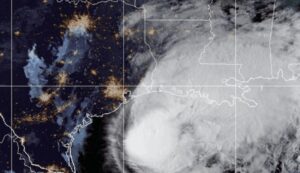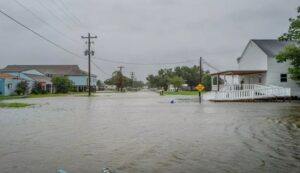‘Dangerous’ Hurricane Francine shown approaching Louisiana: Video
Louisiana: Hurricane Francine, forecasted at Category 2, struck beaches in Louisiana late Wednesday night, while displacing people and disturbing their daily activities through high wind, outages, and flooding in a critically exposed coastal zone.

The storm made landfall in hammon Louisiana in Terrebonne Parish around 5 p.m. The report by The National Hurricane Center (NHC) indicates a wind gust of 96 miles an hour. There were suggestions from some journalists that the New Orleans area was already experiencing hurricane-force winds by eleven o’clock at night and flash floods were reported in local publications.
In this particular bulletin on Wednesday night, NHC forecasters made recess to access up to three hours after hurricane landfall that during such periods, “the danger of life-threatening storm surge. . . remains over the beaches of Louisiana and Mississippi.” There is no active evacuation in the area; rather, citizens are advised that “people should stay in a safe place and avoid moving until the situation is safe to come out”.
Heavy rain and hurricane-force winds are spreading inland across southern Louisiana as Hurricane Francine makes landfall. @JimCantore is live in Morgan City with the latest. pic.twitter.com/PilpJ8HxNS
— The Weather Channel (@weatherchannel) September 11, 2024
As the storm debris and flood water were rushing down the urban streets, videos of the same becoming very popular on social media, and trees and building blocks were falling down due to the hurricane wind. At around six pm a clip was transmitted from Morgan City, Louisiana, where Jim Cantore, a mild-mannered meteorologist, was being battered by wind and rain on the Weather Channel. The footage was uploaded on X, previously Twitter.
Meteorologist Reed Timmer also recorded another video from a moving car when the storm was making its way across New Orleans. The video, which was uploaded at 8:55 pm, shows water swelling over the road and the driver’s window completely covered with rain, thus making it impossible for the motorist to see anything outside.
Earlier in the evening, veteran meteorologist David Bernard made a post on X that said, “This is a Particularly Dangerous Situation.”.
In another message, he elaborated, “Tonight, one of the largest floods in a decade is happening all over the New Orleans metropolitan area.” “It also appears as though we ourselves have no idea as to the level of damage caused by the terrible weather.”
Geiger told the associated press that emergency officials said the storm snapped power lines and uprooted trees in Morgan City, some 30 miles north of where the hurricane made landfall in Francine. As the hurricane approached the city, there was also rapid onset water inundation.
Alvin Cockerham, the Morgan City fire chief, never denied saying, ‘Well, it is a little bit worse than what I would have thought, looking at the damage on the engineer’s report. “I went back to the same fire station in one of my vehicles, all contents intact. Going out in this weather is too dangerous,’ he said.”
, At about 8:38 Westminster time, WeatherNation’s Erik Fox videoed and posted to his X account that search and attack teams were conducting a search for people within the vicinity of those structures that were built in Houma, Louisiana, after a storm flattened the building.
During a later cover from WDSU New Orleans, pictures of a “good Samaritan” inside water rescue attempting to save a motorist who had gotten stuck in their pickup truck where water levels rose dangerously close to the canal underpass.
With the help of a gray-suited man, the driver was assisted in exiting the rear window of Four Rings Car H-9903 hand in a spatula, intimidated. Even as the rescuing of the motorist was happening, there were reports on emergency responders who were also within the periphery of the case.

Let’s turn the pages of one WDSU anchor Douglas, this person in gray rain storm suit standing by the man’s sideline, went, ‘wow, this person has just prevented cold rain pushing over himself’—today and yesterday.
The Atlantic hurricane season has a total of six named storms so far, and the sixth one is named Francine. While the National Oceanic and Atmospheric Administration forecasted naming 17 to 25 storms for this season, it is still more than the average, according to meteorology experts. The Atlantic hurricane season starts on June 1 and lasts until November 31.
However, the NHC estimates that the storm will push further north on Wednesday night and Thursday into central Mississippi and clip Arkansas, only to affect Missouri and Tennessee by Friday night. Water affects Shreveport-Bossier City and southern areas of Louisiana and Mississippi through the storm, as some areas of Mississippi can receive 6 inches of rain.
This outline on flash flood risk for New Orleans as well as the lower part of Jackson is based on NHC southern predictive modeling valid as of Wednesday night.
Meanwhile, Newsweek presents that late Wednesday night contacted the Louisiana Governor’s Office of Homcuts and Emergencies for more details.